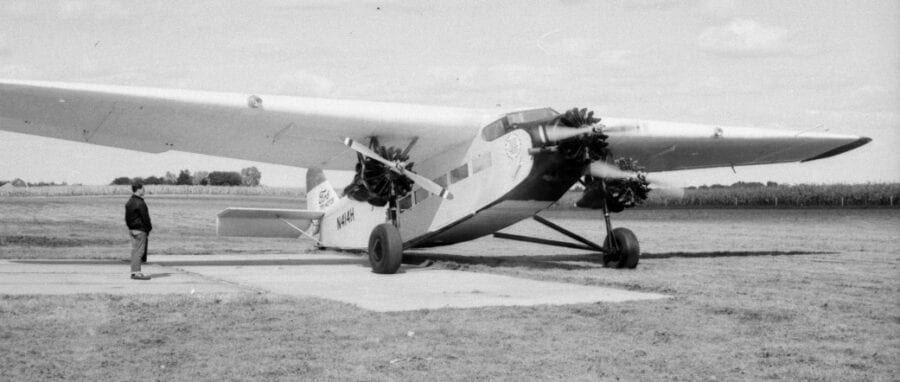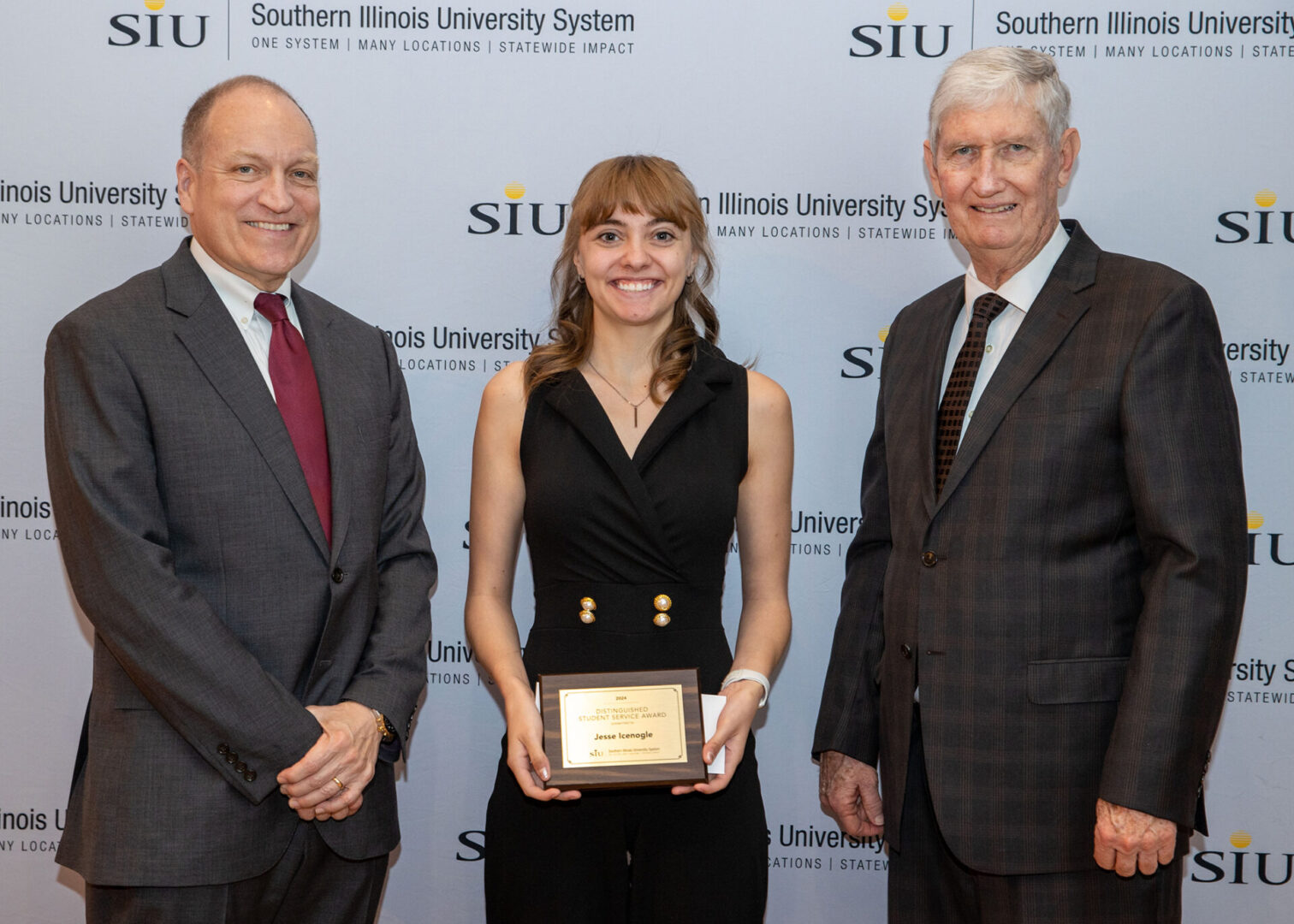Story Courtesy of Jeff Rankin, Monmouth College Historian Author and Literacy Critic.
If you recall the original Monmouth Airport, which operated on North 6th Street between 1922 and 1967, chances are the name “Tin Goose” still evokes fond memories.
Although unusual, the nickname aptly describes a very special Ford Tri-Motor airplane that flew from that grass runway between 1959 and 1965. With an outer body constructed entirely of corrugated aluminum and boasting three 450-horsepower 9-cylinder engines, the historic 1929 aircraft was loud and ungainly looking, but powerful. Area residents who were lucky enough to catch a ride in its 15-seat mahogany-paneled cabin experienced the same thrill enjoyed by commercial passengers in the early days of aviation.
Officially known by its registration number N414H, the Tin Goose was the pride and joy of airport operator and certified mechanic John Louck, who lovingly restored the aviation relic.
Born in Muscatine, Iowa, in 1914, Louck had flying in his blood, after having studied aviation at Lane Tech High School, where he graduated in 1932. He then began working in his parents’ grocery store in Burlington, while also taking flying lessons at the Burlington airport. By 1938, he started crop dusting, a dangerous occupation that would eventually become his main source of income.
Louck entered the Army Air Corps in 1941 as a flight instructor and worked his way up to captain. Following World War II, he purchased Monmouth Municipal Airport along with local auto dealer Hiram A. Martin, who owned the land it occupied. The airport in 1946 was a bustling place with 30 student airplanes lining its runway. In addition to crop dusting, Louck served as an instructor to 260 ex-GIs, as well as 97 Monmouth College students, who received academic credit for their lessons.
But the Korean War took its toll on the operation, when the National Guard called some of his best pilots, leaving Louck with just two employees. As a result, he began branching out, doing crop dusting in 10 states, from Minnesota to Mississippi. In one season, he and his crew sprayed 20,000 acres of cotton and laid down fertilizer on 8,000 acres of land. On one busy day, he made 71 landings and takeoffs, hauling 600 pounds of fertilizer each trip.
By his mid-40s, the exhausting schedule and hazardous work made Louck reconsider his career path, especially after seeing “barnstorming” pilots make good money taking passengers on brief flights. In the summer of 1959, he heard about a plane in Florida that would not only change his career but also bring him national fame.
When Louck took possession of the Ford Tri-Motor, it had been sadly neglected and was full of frogs, snakes and insects. It took him two weeks to get it cleaned up and airworthy, but due to unforeseen problems it took 68 days to get the aircraft to Monmouth. After replacing crop dusting equipment with seats and changing out the engines, the plane was ready for a new chapter in its colorful life. Piloted by Jack Marshall of Birmingham, Ala., who flew B-17s in World War II and B-26s in Korea, the Tin Goose began an extensive barnstorming career throughout the country. In one year, it carried 17,000 passengers at $3 per ride.
The N414H was the 155th of just 199 Tri-Motors ever built by the Ford Motor Co. Originally on twin floats, it was designed as a torpedo bomber for the Navy. Considered too slow for battle, the Navy first planned to convert it to a troop transport, but in 1931 sold it to Pan American Airlines for passenger service from Miami to Central America.
In 1935, it began operating in Mexico City, and by 1941, it moved further south to Guatemala, where it was the first mail plane to operate in South America. During this time, it transported guns and revolutionaries, and at one point its seats were removed to relocate an entire mine—transporting mules, steel beams and timbers over the jungle. It then hauled chicle (used in chewing gum) out of Guatemala under contract with the Wrigley Company.
By the 1950s, the plane was reconditioned as an aerial sprayer for the U.S. forestry service, flying over Montana, Oregon and Washington State. It was used to fight a grasshopper plague and to drop borax on forest fires. At the time Louck purchased it, there had been plans to send it to French Guiana for service again as an airliner.
A beloved local attraction at the Monmouth Airport, the Tin Goose would gain national attention in 1963, when Louck leased it to TWA to commemorate the 25th anniversary of the signing of the Civil Aeronautics Act by Franklin Roosevelt in 1938. As a publicity stunt, the airline reenacted its first transcontinental all-air passenger service in 1930, flying from Los Angeles to Newark, N.J.
Louck and Marshall were two of the four pilots chosen for the run, along with Dave Runyan of Bushnell and Lee Flanagan of Los Angeles, the oldest pilot in the TWA system, who began flying for the airline the year of its maiden run. Also on board was TWA’s first stewardess, Miss Thelma Harmon.
The plane drew huge crowds at airports along the way, including an estimated 38,000 spectators in Washington, D.C. On its way back to Los Angeles for decommissioning, a stop was made at the historic Monmouth Airport, which had been a principal air mail station in the early days of flight.
When the Smithsonian Institution began building its National Air Museum, American Airlines promised its own antique Tri-Motor for the exhibit, but soon decided to look for a replacement, so in February 1965 Louck agreed to sell his beloved plane to the airline. Later that year, it was exhibited at the New York World’s Fair.
A barnstorming pilot purchased the Tin Goose in the 1970s and it repeated its cross-country flight. In the 1980s, it flew out of Los Angeles and enjoyed a brief movie career, being repainted to resemble one of Hitler’s private Junkers in the Mel Brooks movie “To Be Or Not To Be.”
The Tin Goose ended its commercial career giving tourist flights over the Grand Canyon. It’s currently listed on a classic aircraft broker’s website with a price tag of $1.4 million.














